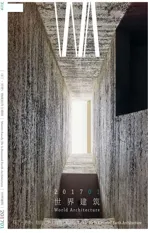匠人的坚韧与诗学
2017-04-06张利
张利
匠人的坚韧与诗学
张利
在1980年代,夯土建筑还只是逝去的乡土气息的片断,被建筑师带着同情心与怀旧感看待。今天,夯土建筑已经成为了可持续建造工艺的表率,被全世界的建筑师所关注。有一个人为这一变化作出了重要的贡献,他就是马丁·劳奇。
作为一个生活在阿尔卑斯山西侧的奥地利人,劳奇将奥地利人的开放心态与瑞士人的严谨工艺结合到了一起。在早年于非洲接触到夯土建造工艺以后,他把随后的大半生灌注到了对夯土工艺的改良与创新之中,赋予了土这一古老的建筑材料以全新的生命。他与他的团队成员一起,在其现代化的建造实验室内创造了一系列建造工法。随着劳奇在各大学的教学,与现代夯土工艺相关的技术与美学传遍了欧洲和世界其他地区。不幸的是,时下流行的、中产阶级色彩浓厚的观点仅仅注意到了夯土的美学,把它看成了一种时尚甚至是情怀,而忽视了工艺的价值,这实在对劳奇与同事们的工作有所不公。劳奇的夯土工艺需要用文艺复兴式的全体论观点来看待:设计者、材料发明家与匠人融为一体。在劳奇的作品中,我们看到的正是数十年来一个匠人的坚韧与诗学。
夯土绝非完美的建筑材料(我怀疑是否真的有完美的建筑材料)。即便是在当今西方的价值观给予夯土一些额外支持的情况下,夯土仍然有很多问题需要回答。
首先一个问题是土的来源。环境主义者会对任何从地表开采土的行为表示担忧。在人口密集的国家,比如中国,人们更有理由担心是否应该用土来盖房子,因为保留土壤给食物的生产显然意义更重大。劳奇与同事们对此的解释是,他们从未用过适于耕作的土壤,而是从更“安全”的地方采土,比如荒漠和干涸的河床。
第二个问题是对气候侵蚀的抵御。侵蚀是土的固有的问题。没有哪个土的构筑物会在自然母亲的怀抱中待上10年,而不损失其相当一部分表面。劳奇与同事们把这一挑战看成是一个特性。用建筑立面水平线条下随时间而加重的阴影来标识时间的演进,这不是个坏主意。当然,劳奇与同事们在此还有更多的事要做:说服在社会上无处不在的铁杆维特鲁威主义者,夯土不仅“美观”,而且“坚固”。
第三个问题是成本。在发达国家,劳奇的标签式的夯土质感已经成为了被广为追捧的格调。因为在这些国家人工成本远高于工业加工成本,夯土的造价比类似的表达厚重与塑性的材料——比如混凝土——要贵出不少。劳奇与同事们正在研究的工业化生产方式,比如预制的夯土构件等,正是为降低这一材料造价所做的努力。不过这一问题在发展中国家就没那么突出了,因为在这些国家,人工成本相对较低,工业制造成本相对较高。以至于在中国的偏远地区,我们甚至能够看到夯土工艺在建造成本上的潜在优势。
感谢马丁·劳奇及其事务所使本期专辑成为可能。特别感谢劳奇事务所的克莱门斯·奎林,他的倔犟与执着使本期专辑的所有文字在技术上更加精准。我们还要在此向部分应邀撰写评论的学者致歉,因为技术准确性的原因,在劳奇事务所的坚持下,我们没有刊登部分评论文字。□
Back in the 1980s, rammed earth buildings were veneers of the lost vernacular and were looked upon by architects with nostalgia and sympathy. Today, they are examples of sustainable construction and are admired by architects worldwide. One man has made substantial contribution in making this happen: Martin Rauch.
Being an Austrian living on the west side of the Alps, Martin has combined an Austrian open-mindedness with a Swiss sense in making. Contacting African rammed earth construction in the early days of his career, he has since spent his life in the development, revision, sophistication and innovation of processes related to this old material and has given it a new life. He and his team, with their modern fab-lab, pioneer in the research for new working processes for rammed earth. His teachings has brought the tech know-hows, along with the unavoidable aesthetics of rammed earth architecture around Europe, and the rest of the world. Unfortunately, the spreading Bourgeois view on rammed earth architecture today, which sees it as pure fashion or even posh taste, is not doing Martin and his colleagues justice. Martin's approach on rammed earth architecture needs to be understood in the Renaissance holistic pattern, in which the designer, material scientist and the builder uniting into one. In his work, we do see decades worth of perseverance and poetics of a craftsman.
Rammed earth is not a perfect building material though (I have doubt there is such a thing called perfect building material). Even with the contemporary political correctness giving it a slight edge, rammed earth still has to answer a number of questions.
The first question is related to the source of the earth. Environmentalists may have some concerns over any earth taken from the surface of the planet. In densely populated countries like China, there is a particular concern that soil should be reserved for food production other than be used for building construction. The argument from Martin and his colleagues is that they are not hurting any arable land, that their main sources of earth are "safer sources", such as deserts and dried river beds.
The second question is related to weather resistance. Earth gets eroded, period. There is no way for an earth-construction to stand in the arms of mother nature for ten years without losing a substantial part of its surface. Martin and his colleagues take this challenge as a feature. They have designed processes that embraces the interaction between the built surface and its environment. A gradually deepening shadow beneath a horizontal band in a building facade as a registration of time is not a bad idea at all. Of course, Martin and his colleagues need to persuade a big chunk of die-hard Vitruvian clients that unharmful erosion not only adds to delight, but also maintains firmness.
The third question is cost. In the developed world, Martin's signature rammed earth texture is a highly regarded commodity. Because of the human labour involved, it is more costly than other materials of weight and plasticity, such as concrete. Martin and his colleagues are working on industrial methods, such as pre-fab processes, that can significantly reduce the cost. In the developing world though, the question is much less obvious. The relatively low cost of human labour and the relatively high cost of industrial manufacturing evens things up. In the Chinese countryside, we can even see some cost benefits of rammed earth construction comparing with steel and concrete.
Our thanks to Martin Rauch and his office for making this publication possible. In particular, our thanks to Clemens Quirin for his rigorous and professional work in making this publication more precise. We would also like to make an apology to our invited critics that due to technical issues, by the requests from Martin's office, we have redacted some of the comments. □
The Perseverance and Poetics of a Craftsman
ZHANG Li
清华大学建筑学院/《世界建筑》
2017-01-11
